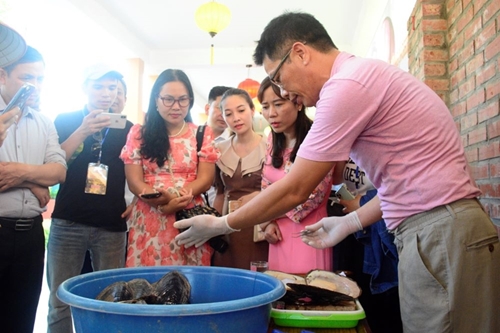Apart from jewelry, Ninh Binh's freshwater pearls are used to decorate pens, notebooks, car hangers and more. According to Dinh Van Viet, Director of Hong Ngoc Pearl Private Enterprise, a freshwater pearl production facility in Khanh Loi commune, these products are made in the hope of raising Vietnamese tourism products’ level. Attentively, the pearls for these products are all cultured from freshwater mussels, not seawater mollusks.
    |
 |
|
Tourists observe Dinh Van Viet’s performance of transplantation on mussels. |
Viet shared that the climate and soil conditions in his countryside are suitable for freshwater mussels to develop pearls.
Actually, Vietnam started researching freshwater pearl cultivation in the 1970s. Many state-level research projects have not been put into operation for many reasons, mainly because of incomplete technical process.
In the world, China is a veteran producer of freshwater pearls, with tons of pearls marketed each year. Pearls here are mainly cultured by tissue, a technique that tissue is transplanted into the mantle tissue at the posterior part of a living mussel. Currently, this kind of pearls accounts for approximately 70% of the world market share thanks to their low price, large output. However their quality is not high because of their distorted shapes, soft texture, and hollows in the middle.
Dinh Van Viet is specialized in Akoya pearls originating from Japan. He tried his hand at mussels in many regions of Vietnam. However, upon returning to the hometown in Khanh Loi commune, he suddenly realized that he could try his hand at freshwater mussels. In fact, it was not easy to produce pearls from freshwater mussels. He failed many times. Even he shed lots of sweat and tears, the mussels died in large numbers. His dream of freshwater pearls was shattered. In these difficult times, it was the military discipline and sense of responsibility to pursue his passion that he had strictly observed and raised while serving in the military, together with the pride of his father and older brother, who are Uncle Ho’s soldiers, lifted him.
He also grew up from experience. Learning about the technique of transplanting hard cores and cell tissue for round pearls, with a high hardness value, and a price equal to that of Akoya pearls, he wanted to follow suit. However, the failure rate of this technique was up to 80%. In seven years, starting from 2010, he failed countless times. However, his efforts were paid off. He successfully applied the aforementioned technique on thick-shelled black mussels and thin-shelled green mussels. Hong Ngoc Pearl became the first unit in Vietnam to research and successfully apply the technique with success rate of more than 80%, producing pearls diverse in colors.
According to Viet, on average, Hong Ngoc Pearl annually produces tens of thousands of freshwater pearls, including thousands of quality pearls, each worth from millions to tens of millions of VND. “These are also a favored tourism product because of their beautiful colors and more affordable price compared to saltwater pearls,” Viet said.
Translated by Mai Huong